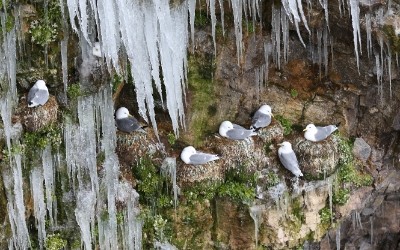Monitoring the time of breeding
For most organisms, good timing is absolutely crucial to success. This is especially the case when they invest in activities that are particularly energy demanding, such as breeding and moulting. The better these activities correspond to peaks in the occurrence of prey species, the lower the risk of high energy use, and consequently the lower the cost of achieving good breeding success. Timing the start of breeding well is an extra challenge, as birds’ energy needs are highest when feeding their young (which occurs many weeks after egg-laying), and the young are also dependent on having good access to food when they leave the colony.
See SEAPOP’s data series for the seabirds’ phenology
Search for data on phenology in our data portal
Climate changes threaten time-sensitive processes

Maintaining a balance between energy use and food availability is naturally a challenge faced by any animal. Large variation in oceanographic conditions from year to year therefore leads to considerable variation in the production of different trophic levels, and thus also in the food options for seabirds. Besides, undirectional climate changes can lead to a gradual temporal displacement of these processes, which not all species are capable of adapting to equally well.
Production at the lowest trophic levels is to a large extent driven by light and temperature, and an ever warming climate can therefore limit the temporal window individuals need to achieve adequate fitness before the start of breeding. As a result, they may not manage to lay (enough) eggs in time to exploit the peak in the occurrence of prey species in an optimal manner. Over time, the cost of reduced production can be reduced recruitment and population decline.
To breed or not to breed?
Many seabirds have a low threshold for nest abandonment, and can leave eggs or young if the conditions become so poor that continued nesting reduces the birds’ chances for survival. They can also choose to not breed for one or several years. For adult seabirds, which normally have a high annual survival rate (80-95 %), this is a good adaptation to the very variable and unpredictable environment that we have at our latitudes. In this case, it can often be advantageous to give up early and rather bank on better breeding conditions in the following year.
Nevertheless, adult survival can also be reduced with more extreme reductions in food availability, and can contribute towards larger and more long-term population declines than those experienced by species with faster production. By monitoring the timing of breeding simultaneously with breeding success and survival, it is possible to reveal the ecological processes and responses in greater detail than otherwise possible.
